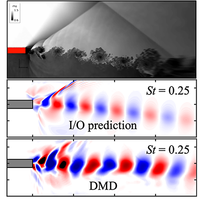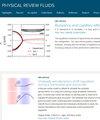Responses to disturbance of supersonic shear layer: Input-output analysis
IF 2.5
3区 物理与天体物理
Q2 PHYSICS, FLUIDS & PLASMAS
引用次数: 0
Abstract
We investigate the perturbation dynamics in a supersonic shear layer using a combination of large-eddy simulations (LES) and linear-operator-based input-output analysis. The flow consists of two streams—a main stream (Mach 1.23) and a bypass stream (Mach 1.0)—separated by a splitter plate of nonnegligible thickness. We employ spectral proper orthogonal decomposition to identify the most energetic coherent structures and bispectral mode decomposition to explore the nonlinear energy cascade within the turbulent shear-layer flow. Structures at the dominant frequency are also obtained from a resolvent analysis of the mean flow. We observe higher gain at the dominant frequency in resolvent analysis, indicating the dominance of Kelvin-Helmholtz (KH) instability as the primary disturbance energy-amplification mechanism. To focus on realizable actuator placement locations, we further conduct an input-output analysis by restricting a state variable and spatial location of an input and output. Various combinations of inputs and output indicate that the splitter plate trailing surface is the most sensitive location for introducing a perturbation. Upper and lower surface inputs are less influential in modulating wavepackets in the shear layer but introduce pressure instability waves in the main and bypass streams, respectively. The analysis reveals that the phase speed of pressure waves depends on the state variable and input location combination. For all combinations, the KH instability plays a key role in amplification, which reduces significantly as the input location is moved upstream relative to the splitter plate trailing edge. Furthermore, two-dimensional nonlinear simulations with unsteady input at the upper surface of the splitter plate show remarkable similarities between pressure modes obtained through dynamic mode decomposition and those predicted from linear input-output analysis at a given frequency. This study emphasizes the strength of linear analysis and demonstrates that predicted coherent structures remain active in highly nonlinear turbulent flow. The insights gained from the input-output analysis can be further leveraged to formulate practical flow control strategies.

超音速剪切层的扰动响应:输入输出分析
我们采用大涡流模拟(LES)和基于线性操作的输入输出分析相结合的方法研究了超音速剪切层中的扰动动力学。气流由两股气流组成--一股主气流(马赫数 1.23)和一股旁路气流(马赫数 1.0)--被一块不可忽略厚度的分流板隔开。我们采用光谱正交分解来识别能量最高的相干结构,并采用双谱模分解来探索湍流剪切层流中的非线性能量级联。通过对平均流进行解析分析,我们还获得了主频处的结构。我们在解析频谱分析中观察到主频处的增益较高,这表明开尔文-赫尔姆霍兹(KH)不稳定性是主要的扰动能量放大机制。为了重点关注可实现的致动器放置位置,我们通过限制状态变量和输入输出的空间位置,进一步进行了输入输出分析。各种输入和输出组合表明,分流板尾部表面是引入扰动最敏感的位置。上表面和下表面输入对剪切层的波包调制影响较小,但会分别在主流和旁流中引入压力不稳定波。分析表明,压力波的相位速度取决于状态变量和输入位置组合。在所有组合中,KH 不稳定性都起着关键的放大作用,当输入位置相对于分流板后缘向上游移动时,放大作用显著减弱。此外,在分流板上表面进行非稳态输入的二维非线性模拟显示,在给定频率下,通过动态模式分解获得的压力模式与线性输入-输出分析预测的压力模式之间具有显著的相似性。这项研究强调了线性分析的优势,并证明了预测的相干结构在高度非线性湍流中依然活跃。从输入输出分析中获得的启示可进一步用于制定实用的流动控制策略。
本文章由计算机程序翻译,如有差异,请以英文原文为准。
求助全文
约1分钟内获得全文
求助全文
来源期刊

Physical Review Fluids
Chemical Engineering-Fluid Flow and Transfer Processes
CiteScore
5.10
自引率
11.10%
发文量
488
期刊介绍:
Physical Review Fluids is APS’s newest online-only journal dedicated to publishing innovative research that will significantly advance the fundamental understanding of fluid dynamics. Physical Review Fluids expands the scope of the APS journals to include additional areas of fluid dynamics research, complements the existing Physical Review collection, and maintains the same quality and reputation that authors and subscribers expect from APS. The journal is published with the endorsement of the APS Division of Fluid Dynamics.
 求助内容:
求助内容: 应助结果提醒方式:
应助结果提醒方式:


